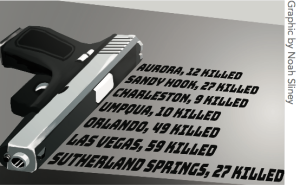Resisting complacency in the age of mass shootings
By: Mary Wilson
Staff Writer
 There is a pattern. First, a horrible tragedy. Innocent people are brutally murdered. People are gunned down in a nightclub. Bullets rain down at a music festival. Places of worship are turned into places of terror. Children and the teachers protecting them are slaughtered just before Christmas.
There is a pattern. First, a horrible tragedy. Innocent people are brutally murdered. People are gunned down in a nightclub. Bullets rain down at a music festival. Places of worship are turned into places of terror. Children and the teachers protecting them are slaughtered just before Christmas.
Next, there are thoughts and prayers. A profile picture filter change on Facebook. A list of the victims circulates around social media. Then, we forget. It happens slowly: the debate that rises up over gun control simmers down from a boil, then grows cold. Facebook profile picture filters switch back. The families of the victims are left knowing that their nation has forgotten about their loved ones. Until the next tragedy.
We mourn, but no new legislation is introduced. After all, it was too early to talk about gun control after Columbine. It was not the right time to talk about gun control after Aurora. It was not appropriate to talk about gun control after Sandy Hook. And Charleston. And the Umpqua Community College Shooting. And Orlando. And Las Vegas. And, most recently, the Texas church massacre. How much is enough? How many more innocent people have to die? When is the right time to talk about this?
In the only nation where this regularly happens, we say that there’s nothing we can do. The Second Amendment gives us Americans the right to bear arms, after all. Stronger background checks would not accomplish anything. It’s a mental health problem, they say; the mental health-care system is broken!
Yes, the mental health-care system is broken. However, according to mentalhealth.gov, only 3%-5% of violent acts can be attributed to individuals living with a serious mental illness. Furthermore, only addressing the mental health-care system and those living with mental illness after a mass shooting further stigmatizes the mentally ill and perpetuates the dangerous myth that those with mental health problems are violent.
In the only nation where this regularly happens, we have a choice. It’s in the Constitution. The Second Amendment was ratified in 1791. The guns we use today are unimaginable to the guns our founding fathers used. We can sit back and let comfortable complacency take over.
Or, we can get up and fight. We can move forward with the uncomfortable feeling of change. We can call our legislators; we can have difficult conversations with our family members. Do everyday citizens really need a semi-automatic weapon, capable of killing and seriously injuring humans in large quantities?
When most of the weapons used in mass killings in the United States are obtained legally, we have a problem. When our children recognize intruder drills at school as normal, hiding hushed in a closet, we have a problem. When 58 music festival attendees are murdered, we have a problem. When 49 people are murdered in a nightclub, we have a problem. When 20 six and seven-year-olds are murdered in their classrooms, we have a problem. When 26 people are murdered in a place of worship—thoughts and prayers doing nothing to protect them—we have
a problem.
This list could go on for pages. We have a problem, and it’s up to us to fix it. Now is the time to take action. Hundreds of lives have been ended. What will you do?










